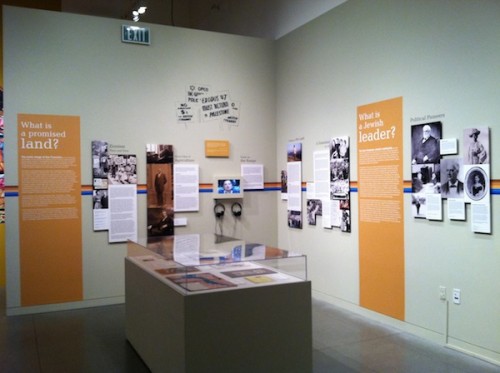There Is a There There
California Dreaming, an exhibition at the Contemporary Jewish Museum, pays tribute to Jews whose dreams have shaped the character of life in the Bay Area from the Gold Rush era to the present. This is not a pantheon-building exercise, though. While iconic figures do play prominent roles in CJM’s historical pageant, the exhibition commemorates their deeds without representing history as a procession of “great men.” Levi Strauss, for instance, is represented by examples of the things his company made, including a policy of nondiscrimination, as well as 501 jeans and denim yarmulkes.

California Dreaming (installation shot), Contemporary Jewish Museum
Honoring the Jewish spirit of inquiry, the exhibition unfolds as a series of questions: “What does it mean to be first?” “If I am only for myself, what am I?” “Is there a there there?” “What is a promised land?” “What is a Jewish leader?” As former CJM Director Connie Wolf, who conceived of the exhibition, explained, “We’re presenting this history in a new way, through a series of questions to engage visitors in thinking about their own role in creating and sustaining community.”
California Dreaming includes interactive components that invite members of the museum’s community to append their own personal photos and stories to this narrative. A constantly shifting montage of images evoking the diversity and complexity of “being Jewish” in the Bay Area can be accessed both online and in person. This open-ended visual narrative unfolds on a monitor at the very entrance to the gallery, an inclusive and expansive gesture that sets the tone for the whole exhibition.

Rachel Schreiber, Site Reading, 2011; commissioned by the Contemporary Jewish Museum for California Dreaming
An adjacent installation, commissioned from the Bay Area conceptual photographer and cultural historian Rachel Schreiber, differently embodies the exhibition’s philosophical orientation. Schreiber’s Site Reading presents a series of counter-monuments — photographs of locales not distinguished by historical markers, where acts of untouted generosity, creation, courage, solidarity, activism, and ingenuity transpired. Schreiber has paired these images of unremarkable sites with short biographical texts that illuminate disproportionately remarkable lives. The image/text couplets span an entire wall, stretching out against a deep blue decor in orderly succession. This display contrasts with the warm palette and hodgepodge aesthetic that characterize the rest of the exhibition. The relative sobriety of Schreiber’s installation imbues this Site Reading zone with an aura of restrained reverence. Cumulatively, the framed works aligned here hint that there’s something sacred about the secular scenes Schreiber singled out to photograph. Because of the installation’s location near the exhibition’s entrance/exit, it is either the visitor’s first or last experience — and it works equally well as a prologue or a coda. As we come or go, we are confronted with Schreiber’s heterotopias, layered with historical significance that is always only partially visible. Each place, each non-place, is a monument to the engagements, struggles, triumphs, and failures to which ordinary scenes like these bear constant witness.
About the people whose spirits still haunt these sites, Schreiber says, “Their histories surround us: a typical San Francisco business district street corner formerly housed a Communist-affiliated labor school where a Jewish poet taught; a ranch amidst the golden hills of Petaluma was the site where Eastern European Jews taught themselves to raise chickens; a San Francisco convention center showcasing cutting-edge Silicon Valley technology was the location of a 19th-century union hall where a Jewish labor activist argued against anti-Chinese discrimination; east of the Sierras, in a remote desert valley, a memorial stands to a Japanese internment camp at which a Jewish woman cared for her son. As varied in topography as are the spaces that make up the Bay Area, these are all sites in which such histories can be revealed.”

Rachel Schreiber, Site Reading, 2011; commissioned by the Contemporary Jewish Museum for the exhibition California Dreaming

Rachel Schreiber, Site Reading, 2011; commissioned by the Contemporary Jewish Museum for the exhibition California Dreaming

Rachel Schreiber, Site Reading, 2011; commissioned by the Contemporary Jewish Museum for the exhibition California Dreaming

Rachel Schreiber, Site Reading, 2011; commissioned by the Contemporary Jewish Museum for the exhibition California Dreaming

Rachel Schreiber, Site Reading, 2011; commissioned by the Contemporary Jewish Museum for the exhibition California Dreaming

Rachel Schreiber, Site Reading, 2011; commissioned by the Contemporary Jewish Museum for the exhibition California Dreaming

Rachel Schreiber, Site Reading, 2011; commissioned by the Contemporary Jewish Museum for the exhibition California Dreaming

Rachel Schreiber, Site Reading, 2011; commissioned by the Contemporary Jewish Museum for the exhibition California Dreaming